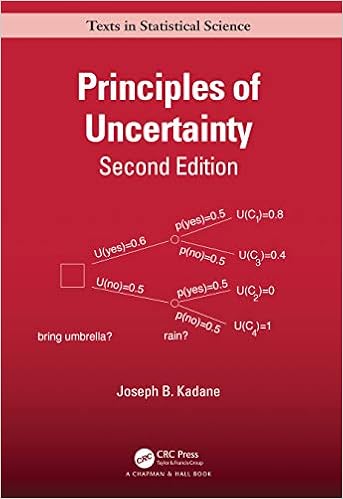 A new edition of Principles of Uncertainty is about to appear. I was asked by CRC Press to review the new book and here are some (raw) extracts from my review. (Some comments may not apply to the final and published version, mind.)
A new edition of Principles of Uncertainty is about to appear. I was asked by CRC Press to review the new book and here are some (raw) extracts from my review. (Some comments may not apply to the final and published version, mind.)
In Chapter 6, the proof of the Central Limit Theorem utilises the “smudge” technique, which is to add an independent noise to both the sequence of rvs and its limit. This is most effective and reminds me of quite a similar proof Jacques Neveu used in its probability notes in Polytechnique. Which went under the more formal denomination of convolution, with the same (commendable) purpose of avoiding Fourier transforms. If anything, I would have favoured a slightly more condensed presentation in less than 8 pages. Is Corollary 6.5.8 useful or even correct??? I do not think so because the non-centred average rescaled by √n diverges almost surely. For the same reason, I object to the very first sentence of Section 6.5 (p.246)
In Chapter 7, I found a nice mention of (Hermann) Rubin’s insistence on not separating probability and utility as only the product matters. And another fascinating quote from Keynes, not from his early statistician’s years, but in 1937 as an established economist
“The sense in which I am using the term uncertain is that in which the prospect of a European war is uncertain, or the price of copper and the rate of interest twenty years hence, or the obsolescence of a new invention, or the position of private wealth-owners in the social system in 1970. About these matters there is no scientific basis on which to form any calculable probability whatever. We simply do not know. Nevertheless, the necessity for action and for decision compels us as practical men to do our best to overlook this awkward fact and to behave exactly as we should if we had behind us a good Benthamite calculation of a series of prospective advantages and disadvantages, each multiplied by its appropriate probability, waiting to the summed.”
(is the last sentence correct? I would have expected, pardon my French!, “to be summed”). Further interesting trivia on the criticisms of utility theory, including de Finetti’s role and his own lack of connection with subjective probability principles.
In Chapter 8, a major remark (iii) is found p.293 about the fact that a conjugate family requires a dominating measure (although this is expressed differently since the book shies away from introducing measure theory, ) reminds me of a conversation I had with Jay when I visited Carnegie Mellon in 2013 (?). Which exposes the futility of seeing conjugate priors as default priors. It is somewhat surprising that a notion like admissibility appears as a side quantity when discussing Stein’s paradox in 8.2.1 [and then later in Section 9.1.3] while it seems to me to be central to Bayesian decision theory, much more than the epiphenomenon that Stein’s paradox represents in the big picture. But the book dismisses minimaxity even faster in Section 9.1.4:
As many who suffer from paranoia have discovered, one can always dream-up an even worse possibility to guard against. Thus, the minimax framework is unstable. (p.336)
Interesting introduction of the Wishart distribution to kindly handle random matrices and matrix Jacobians, with the original space being the p(p+1)/2 real space (implicitly endowed with the Lebesgue measure). Rather than a more structured matricial space. A font error makes Corollary 8.7.2 abort abruptly. The space of positive definite matrices is mentioned in Section8.7.5 but still (implicitly) corresponds to the common p(p+1)/2 real Euclidean space. Another typo in Theorem 8.9.2 with a Frenchised version of Dirichlet, Dirichelet. Followed by a Dirchlet at the end of the proof (p.322). Again and again on p.324 and on following pages. I would object to the singular in the title of Section 8.10 as there are exponential families rather than a single one. With no mention made of Pitman-Koopman lemma and its consequences, namely that the existence of conjugacy remains an epiphenomenon. Hence making the amount of pages dedicated to gamma, Dirichlet and Wishart distributions somewhat excessive.
In Chapter 9, I noticed (p.334) a Scheffe that should be Scheffé (and again at least on p.444). (I love it that Jay also uses my favorite admissible (non-)estimator, namely the constant value estimator with value 3.) I wonder at the worth of a ten line section like 9.3, when there are delicate issues in handling meta-analysis, even in a Bayesian mood (or mode). In the model uncertainty section, Jay discuss the (im)pertinence of both selecting one of the models and setting independent priors on their respective parameters, with which I disagree on both levels. Although this is followed by a more reasonable (!) perspective on utility. Nice to see a section on causation, although I would have welcomed an insert on the recent and somewhat outrageous stand of Pearl (and MacKenzie) on statisticians missing the point on causation and counterfactuals by miles. Nonparametric Bayes is a new section, inspired from Ghahramani (2005). But while it mentions Gaussian and Dirichlet [invariably misspelled!] processes, I fear it comes short from enticing the reader to truly grasp the meaning of a prior on functions. Besides mentioning it exists, I am unsure of the utility of this section. This is one of the rare instances where measure theory is discussed, only to state this is beyond the scope of the book (p.349).

 This is the last day at
This is the last day at 